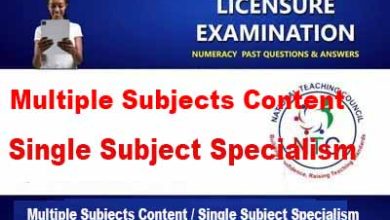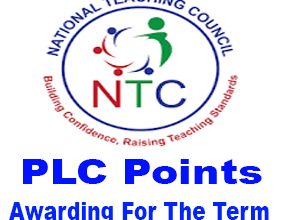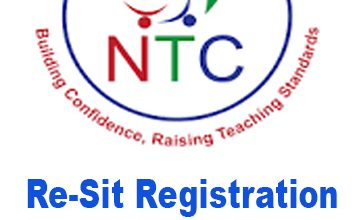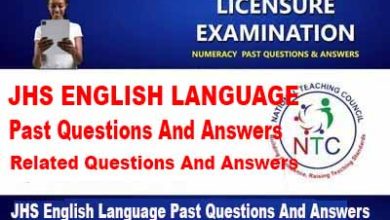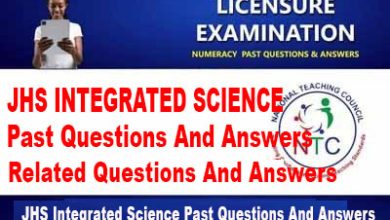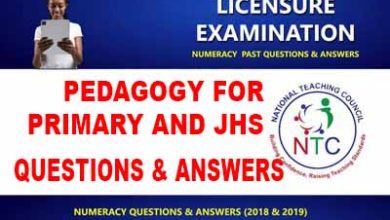NTC Early Childhood/Early Grade Pedagogy Past Questions And Answers
NTC Early Childhood/Early Grade Pedagogy
1. Which one of the following attributes is not an element of intellectual development?
A. Creativity
B. Imagination
C. Thinking
D. Tolerance
Answer: D. Tolerance
NTC Multiple Subject Content For Early Childhood Education Past Questions 4
NTC Multiple Subject Content For Early Childhood Education Past Questions 3
NTC Multiple Subject Content For Early Childhood Education Past Questions 2
NTC Multiple Subject Content For Early Childhood Education Past Questions 1
NTC Professional General Knowledge Past Questions and Answers (Literacy) 2024
NTC Professional General Knowledge Past Questions and Answers (Comprehension 1) 2024
NTC Professional General Knowledge Past Questions and Answers (Literacy) 2024
NTC Professional General Knowledge Past Questions and Answers (Comprehension) 2024
2. Which of the following is considered a crucial aspect of intellectual development in the school system?
A. Memorization
B. Rote learning
C. Critical thinking
D. Repetition
Answer: C. Critical thinking
3. In the context of intellectual growth in schools, which attribute encourages students to explore alternative solutions and perspectives?
A. Rote learning
B. Creativity
C. Obedience
D. Conformity
Answer: B. Creativity
4. Which of the following is essential for fostering innovation and problem-solving skills within the school environment?
A. Encouraging conformity
B. Limiting exposure to diverse ideas
C. Promoting imagination
D. Discouraging independent thinking
Answer: C. Promoting imagination
5. What is a key component of intellectual development that enables individuals to analyze, evaluate, and synthesize information?
A. Rote memorization
B. Encouraging passivity
C. Developing critical thinking skills
D. Avoiding challenges
Answer: C. Developing critical thinking skills
6. Which attribute is fundamental in nurturing students’ ability to adapt to new situations and perspectives in the educational setting?
A. Closed-mindedness
B. Resilience
C. Avoidance of ambiguity
D. Rigid thinking
Answer: B. Resilience
7. Which of the following is a key component of cognitive development in the school curriculum?
A. Athletic ability
B. Thinking
C. Punctuality
D. Dress code
Answer: B. Thinking
8. In the context of developing student skills within the school system, which attribute is primarily associated with emotional and social development rather than intellectual?
A. Creativity
B. Imagination
C. Tolerance
D. Analysis
Answer: C. Tolerance
NTC Multiple Subject Content For Early Childhood Education Past Questions 4
NTC Multiple Subject Content For Early Childhood Education Past Questions 3
NTC Multiple Subject Content For Early Childhood Education Past Questions 2
NTC Multiple Subject Content For Early Childhood Education Past Questions 1
NTC Professional General Knowledge Past Questions and Answers (Literacy) 2024
NTC Professional General Knowledge Past Questions and Answers (Comprehension 1) 2024
NTC Professional General Knowledge Past Questions and Answers (Literacy) 2024
NTC Professional General Knowledge Past Questions and Answers (Comprehension) 2024
9. Which area of development is most directly related to generating new ideas in an educational setting?
A. Discipline
B. Creativity
C. Attendance
D. Conformity
Answer: B. Creativity
10. During a lesson on character building, which attribute would a teacher likely emphasize as crucial for a harmonious classroom environment?
A. Calculus skills
B. Literacy rates
C. Tolerance
D. Imagination
Answer: C. Tolerance
11. In a discussion about student’s progress in early education, which of the following would be considered an essential cognitive skill to develop?
A. Team sports
B. Imagination
C. Uniformity
D. Competitive spirit
Answer: B. Imagination
12. What term best describes parents who prioritize their children’s interests above their own and actively engage in their children’s education?
A. Neglectful
B. Engaged
C. Indifferent
D. Controlling
Answer: B. Engaged
13. When parents consider their children as individuals with their own thoughts, feelings, and rights, they are likely to view them as:
A. Property
B. Persons with rights
C. Objects
D. Pet projects
Answer: B. Persons with rights
14. In the context of parental involvement in the school system, what approach fosters a healthy and productive relationship between parents and children?
A. Authoritarian parenting
B. Neglectful parenting
C. Cooperative parenting
D. Overbearing parenting
Answer: C. Cooperative parenting
15. Parents who prioritize their children’s well-being and development often engage in activities that promote:
A. Autonomy
B. Control
C. Obedience
D. Dependency
Answer: A. Autonomy
16. When parents excessively control and dictate their children’s choices, they are more likely to perceive their children as:
A. Partners
B. Growing plants
C. Equals
D. Individuals
Answer: B. Growing plants
NTC Multiple Subject Content For Early Childhood Education Past Questions 4
NTC Multiple Subject Content For Early Childhood Education Past Questions 3
NTC Multiple Subject Content For Early Childhood Education Past Questions 2
NTC Multiple Subject Content For Early Childhood Education Past Questions 1
NTC Professional General Knowledge Past Questions and Answers (Literacy) 2024
NTC Professional General Knowledge Past Questions and Answers (Comprehension 1) 2024
NTC Professional General Knowledge Past Questions and Answers (Literacy) 2024
NTC Professional General Knowledge Past Questions and Answers (Comprehension) 2024
17. Which one of the following personalities is associated with the concept ‘Zone of Proximal Development’ (ZPD)?
A. Erik Erikson
B. Howard Gardner
C. John Dewey
D. Lev Vygotsky
Answer: Lev Vygotsky
18. Which famous psychologist is known for his theory of psychosocial development, which includes stages such as trust vs. mistrust and identity vs. role confusion?
A. Erik Erikson
B. Howard Gardner
C. John Dewey
D. Lev Vygotsky
Answer: A. Erik Erikson
19. Who introduced the theory of multiple intelligences, suggesting that individuals possess different kinds of intelligences, including linguistic, logical-mathematical, and musical?
A. Erik Erikson
B. Howard Gardner
C. John Dewey
D. Lev Vygotsky
Answer: B. Howard Gardner
20. Which influential philosopher and educator believed in experiential learning, student-centered teaching, and the importance of democracy in education?
A. Erik Erikson
B. Howard Gardner
C. John Dewey
D. Lev Vygotsky
Answer: C. John Dewey
21. This prominent psychologist emphasized the importance of social interaction and the “Zone of Proximal Development” in learning and development.
A. Erik Erikson
B. Howard Gardner
C. John Dewey
D. Lev Vygotsky
Answer: D. Lev Vygotsky
22. Who is known for his stages of moral development and the concept of the psychosocial crisis, framed in terms such as trust vs. mistrust and industry vs. inferiority?
A. Erik Erikson
B. Howard Gardner
C. John Dewey
D. Lev Vygotsky
Answer: A. Erik Erikson
NTC Multiple Subject Content For Early Childhood Education Past Questions 4
NTC Multiple Subject Content For Early Childhood Education Past Questions 3
NTC Multiple Subject Content For Early Childhood Education Past Questions 2
NTC Multiple Subject Content For Early Childhood Education Past Questions 1
NTC Professional General Knowledge Past Questions and Answers (Literacy) 2024
NTC Professional General Knowledge Past Questions and Answers (Comprehension 1) 2024
NTC Professional General Knowledge Past Questions and Answers (Literacy) 2024
NTC Professional General Knowledge Past Questions and Answers (Comprehension) 2024
23. Which one of the following options describes the idea of object permanence as proposed by Jean Piaget? Children …
A. ask questions like adults
B. look for things out of sight
C. achieve language skill
D. wear their dress inside out
Answer: look for things out of sight
24. According to Jean Piaget, what does the concept of object permanence refer to in child development?
A. Asking questions like adults
B. Looking for things out of sight
C. Achieving language skill
D. Wearing their dress inside out
Answer: B. Looking for things out of sight
25. At what stage of Piaget’s cognitive development theory do children typically begin to develop object permanence?
A. Sensorimotor stage
B. Preoperational stage
C. Concrete operational stage
D. Formal operational stage
Answer: A. Sensorimotor stage
26. When a child understands object permanence, they are more likely to demonstrate behaviors such as:
A. Forgetting object location
B. Searching for hidden objects
C. Ignoring objects in plain sight
D. Moving onto new tasks immediately
Answer: B. Searching for hidden objects
27. How does the concept of object permanence impact a child’s interactions with their environment?
A. It leads to increased forgetfulness
B. It promotes curiosity and exploration
C. It decreases observational skills
D. It encourages static thinking
Answer: B. It promotes curiosity and exploration
28. In educational settings, understanding children’s development of object permanence can help educators:
A. Limit their exposure to new objects
B. Tailor teaching methods to cognitive abilities
C. Ignore children’s questions about hidden objects
D. Discourage exploration and curiosity
Answer: B. Tailor teaching methods to cognitive abilities
29. According to Jean Piaget, what milestone signifies the development of object permanence in children?
A. Asking questions like adults
B. Looking for things out of sight
C. Achieving language skills
D. Wearing their dress inside out
Answer: B. Looking for things out of sight
30. At what stage of cognitive development, as described by Piaget, do children typically acquire the understanding of object permanence?
A. Sensorimotor stage
B. Preoperational stage
C. Concrete operational stage
D. Formal operational stage
Answer: A. Sensorimotor stage
NTC Multiple Subject Content For Early Childhood Education Past Questions 4
NTC Multiple Subject Content For Early Childhood Education Past Questions 3
NTC Multiple Subject Content For Early Childhood Education Past Questions 2
NTC Multiple Subject Content For Early Childhood Education Past Questions 1
NTC Professional General Knowledge Past Questions and Answers (Literacy) 2024
NTC Professional General Knowledge Past Questions and Answers (Comprehension 1) 2024
NTC Professional General Knowledge Past Questions and Answers (Literacy) 2024
NTC Professional General Knowledge Past Questions and Answers (Comprehension) 2024
31. What behavior demonstrates that a child has developed object permanence, according to Piaget’s theory?
A. Expressing curiosity about their surroundings
B. Engaging in pretend play with toys
C. Searching for a hidden object
D. Naming familiar objects
Answer: C. Searching for a hidden object
32. In Piaget’s theory of cognitive development, what is the significance of object permanence in a child’s mental representation of the world?
A. It indicates the ability to solve complex mathematical problems.
B. It signifies the beginning of moral reasoning.
C. It represents an understanding that objects continue to exist even when they are not visible.
D. It demonstrates proficiency in social interactions.
Answer: C. It represents an understanding that objects continue to exist even when they are not visible.
33. How does the concept of object permanence contribute to a child’s overall cognitive development?
A. It enhances creativity and imagination.
B. It fosters language acquisition.
C. It lays the foundation for problem-solving skills.
D. It promotes physical coordination and motor skills.
Answer: C. It lays the foundation for problem-solving skills.
34. What distinguishes Montessori’s teaching approach from traditional methods in terms of focus?
A. Teacher-centered
B. Child-centered
C. Subject learning
D. Community-based
Answer: B. Child-centered
35. In Montessori education, where is the emphasis placed regarding the learning process?
A. Teachers dictating all activities
B. Children initiating their learning
C. Rigid subject-matter curriculum
D. Community assessments and exams
Answer: B. Children initiating their learning
36. How does Montessori’s teaching philosophy view the role of teachers in the learning environment?
A. Teachers as sole decision-makers
B. Teachers as facilitators and guides
C. Teachers focusing on lectures only
D. Teachers as subject specialists
Answer: B. Teachers as facilitators and guides
37. What aspect of Montessori’s teaching methods aligns with fostering independence and self-directed learning in students?
A. Relying solely on teacher instruction
B. Memorization of textbook content
C. Encouraging active exploration and choice
D. Confining students to desks for long periods
Answer: C. Encouraging active exploration and choice
38. How does Montessori’s child-centered approach influence student engagement and motivation?
A. By restricting freedom of choice
B. By minimizing interaction with peers
C. By promoting autonomy and curiosity
D. By enforcing rigid learning schedules
Answer: C. By promoting autonomy and curiosity
39. What is a defining characteristic of Montessori’s teaching approach?
A. Teacher-centered instruction
B. Child-centered learning
C. Subject-based curriculum
D. Community-oriented projects
Answer: B. Child-centered learning
40. In a Montessori classroom, what role does the teacher typically play?
A. Delivering lectures and direct instruction
B. Guiding and facilitating children’s exploration and learning
C. Setting rigid academic standards and expectations
D. Focusing primarily on subject-specific content delivery
Answer: B. Guiding and facilitating children’s exploration and learning
NTC Multiple Subject Content For Early Childhood Education Past Questions 4
NTC Multiple Subject Content For Early Childhood Education Past Questions 3
NTC Multiple Subject Content For Early Childhood Education Past Questions 2
NTC Multiple Subject Content For Early Childhood Education Past Questions 1
NTC Professional General Knowledge Past Questions and Answers (Literacy) 2024
NTC Professional General Knowledge Past Questions and Answers (Comprehension 1) 2024
NTC Professional General Knowledge Past Questions and Answers (Literacy) 2024
NTC Professional General Knowledge Past Questions and Answers (Comprehension) 2024
41. What is emphasized in Montessori education in terms of learning activities?
A. Memorization of facts and figures
B. Competitive assessments and tests
C. Hands-on, experiential learning
D. Teacher-directed group discussions
Answer: C. Hands-on, experiential learning
42. Montessori classrooms are known for promoting what type of learning environment?
A. Individualized and self-directed
B. Highly structured and rigid
C. Teacher-dominated and authoritarian
D. Competitive and performance-driven
Answer: A. Individualized and self-directed
43. What is the primary goal of Montessori education?
A. Achieving high standardized test scores
B. Instilling obedience and conformity in students
C. Fostering independence, creativity, and critical thinking skills
D. Emphasizing rote memorization of academic content
Answer: C. Fostering independence, creativity, and critical thinking skills
44. Which early childhood education model places significant emphasis on respect, responsibility, community involvement, learner exploration in a supportive environment, and a curriculum designed based on the learners’ interests?
A. Reggio Emilia Model
B. The Israeli Model (MASHAV)
C. Pencil of Promise model
D. Sabre Education model
Answer: A. Reggio Emilia Model
45. How does the described ECE model encourage learners to engage with their environment and learning experiences?
A. By restricting exploration and discovery
B. By utilizing a rigid and predetermined curriculum
C. By providing a supportive and rich environment for exploration
D. By limiting community involvement in the learning process
Answer: C. By providing a supportive and rich environment for exploration
46. What role does learner interest play in shaping the curriculum of the described early childhood education model?
A. Minimal role in curriculum planning
B. No relevance to the curriculum development process
C. Primary driver for curriculum creation
D. Limited impact on instructional practices
Answer: C. Primary driver for curriculum creation
47. How does the described ECE model foster a sense of community and shared responsibility among learners?
A. By promoting individualistic learning approaches
B. By isolating learners from collaborative experiences
C. By encouraging respect, responsibility, and community involvement
D. By discouraging interaction and community engagement
Answer: C. By encouraging respect, responsibility, and community involvement
48. Which aspect of the instructional practices in the described early childhood education model aligns with creating an environment that supports learner exploration and discovery?
A. Structured and restrictive learning environment
B. Limited access to resources for exploration
C. A supportive and rich environment
D. Minimizing opportunities for hands-on learning experiences
Answer: C. A supportive and rich environment
49. Which early childhood education model prioritizes respect, responsibility, and community involvement as key components of its approach?
A. Reggio Emilia Model
B. The Israeli Model (MASHAV)
C. Pencil of Promise Model
D. Sabre Education Model
Answer: A. Reggio Emilia Model
50. In which early childhood education model do instructional practices encourage learners to explore and discover within a supportive and enriching environment?
A. Reggio Emilia Model
B. The Israeli Model (MASHAV)
C. Pencil of Promise Model
D. Sabre Education Model
Answer: A. Reggio Emilia Model
51. Which early childhood education model designs its curriculum based on the interests of the learners?
A. Reggio Emilia Model
B. The Israeli Model (MASHAV)
C. Pencil of Promise Model
D. Sabre Education Model
Answer: A. Reggio Emilia Model
52. What distinguishes the Reggio Emilia Model from other early childhood education approaches in terms of curriculum development?
A. It follows a standardized curriculum mandated by the government.
B. It emphasizes rote memorization and drill-based learning.
C. It integrates learners’ interests and community involvement into the curriculum.
D. It focuses solely on academic subjects such as math and language arts.
Answer: C. It integrates learners’ interests and community involvement into the curriculum.
53. How does the Reggio Emilia Model foster a sense of responsibility and community involvement among young learners?
A. By implementing strict rules and regulations in the classroom.
B. Through collaborative projects and activities that involve families and the local community.
C. By discouraging interaction and collaboration among peers.
D. By limiting exposure to real-world experiences outside the classroom.
Answer: B. Through collaborative projects and activities that involve families and the local community.
NTC Multiple Subject Content For Early Childhood Education Past Questions 4
NTC Multiple Subject Content For Early Childhood Education Past Questions 3
NTC Multiple Subject Content For Early Childhood Education Past Questions 2
NTC Multiple Subject Content For Early Childhood Education Past Questions 1
NTC Professional General Knowledge Past Questions and Answers (Literacy) 2024
NTC Professional General Knowledge Past Questions and Answers (Comprehension 1) 2024
NTC Professional General Knowledge Past Questions and Answers (Literacy) 2024
NTC Professional General Knowledge Past Questions and Answers (Comprehension) 2024
NTC GTLE Past Question on General Knowledge In Art licensure, NTC GTLE Licensure Past Question on Accounting, NTC GTLE Licensure Past Question on Textiles, NTC GTLE Licensure Past Question on Picture Making, NTC GTLE Licensure Past Question on Integrated Science For SHS, NTC GTLE Licensure Past Question on Integrated Science For JHS, NTC GTLE Licensure Past Question on French, NTC GTLE Licensure Past Question on Business Management, NTC Licensure GTLE Past Question on Career Technology, NTC Licensure GTLE Past Question on Clothing And Textiles, NTC Licensure GTLE Past Question on Economics, NTC Licensure GTLE Past Question on Christian Religious Studies, NTC Licensure GTLE Past Question on Electronics, NTC Licensure GTLE Past Question on English Language For SHS, NTC Licensure GTLE Past Question on Applied Electricity, NTC Licensure GTLE Past Question on Wood Work, NTC Licensure GTLE Past Question on Technical Drawing, NTC Licensure GTLE Past Question on Social Studies For JHS, NTC Licensure GTLE Past Question on Sculpture, NTC Licensure GTLE Past Question on Maths For SHS, NTC Licensure GTLE Past Question on Maths For JHS, NTC Licensure GTLE Past Question on Multiple Subjects Content For Early Grade/Childhood, NTC Licensure GTLE Past Question on ICT For JHS, NTC Licensure GTLE Past Question on Government, NTC Licensure GTLE Past Question on Geography, NTC Licensure GTLE Past Question on Early Childhood Pedagogy, NTC GTLE Past Question on Chemistry, NTC Licensure GTLE Past Question on Building Construction, NTC Licensure GTLE Past Question on Biology, NTC Licensure GTLE Past Question on Ceramics, NTC Licensure GTLE Past Question on Social Studies For SHS, NTC Licensure GTLE Past Question on RME, NTC Licensure GTLE Past Question on General Professional Knowledge, NTC Licensure GTLE Past Question on Physics, NTC Licensure GTLE Past Question on Pedagogy For Primary And JHS, NTC Licensure GTLE Past Question on Management In Living, NTC Licensure GTLE Past Question on Metal Work, NTC Licensure GTLE Past Question on Leatherwork, NTC Licensure GTLE Past Question on Multiple Subjects Content For Primary, NTC Licensure GTLE Past Question on History, NTC Licensure GTLE Past Question on Graphic Design, NTC Licensure GTLE Past Question on Basketry, NTC Licensure GTLE Past Question on Auto Mechanics, NTC Licensure GTLE Past Question on Agriculture Science, NTC Licensure GTLE Past Question on Music, NTC Licensure GTLE Past Question on ICT For SHS, NTC Licensure GTLE Past Question on Ghanaian Languages, NTC Licensure GTLE Past Question on Islamic Studies, NTC Licensure GTLE Past Question on Food And Nutrition, NTC Licensure GTLE Past Question on Creative Art And Design, NTC Licensure GTLE Past Question on English Language For JHS, NTC Licensure GTLE Past Question on Physical Education
Content Areas and Table of Specification Accounting, Content Areas and Table of Specification Textiles, Content Areas and Table of Specification Picture Making, Content Areas and Table of Specification Integrated Science For SHS, Content Areas and Table of Specification Integrated Science For JHS, Content Areas and Table of Specification French, Content Areas and Table of Specification Business Management, Content Areas and Table of Specification Career Technology, Content Areas and Table of Specification Clothing And Textiles, Content Areas and Table of Specification Economics, Content Areas and Table of Specification Christian Religious Studies, Content Areas and Table of Specification Electronics, Content Areas and Table of Specification English Language For SHS, Content Areas and Table of Specification Applied Electricity, Content Areas and Table of Specification Wood Work, Content Areas and Table of Specification Technical Drawing, Content Areas and Table of Specification Social Studies For JHS, Content Areas and Table of Specification Sculpture Content Areas and Table of Specification Maths For SHS, Content Areas and Table of Specification Maths For JHS, Content Areas and Table of Specification Multiple Subjects Content For Early Grade/Childhood, Content Areas and Table of Specification ICT For JHS, Content Areas and Table of Specification Government, Content Areas and Table of Specification Geography, Content Areas and Table of Specification Early Childhood Pedagogy, Content Areas and Table of Specification Chemistry, Content Areas and Table of Specification Building Construction, Content Areas and Table of Specification Biology, Content Areas and Table of Specification Ceramics, Content Areas and Table of Specification Social Studies For SHS, Content Areas and Table of Specification RME, Content Areas and Table of Specification General Professional Knowledge, Content Areas and Table of Specification Physics, Content Areas and Table of Specification Pedagogy For Primary And JHS, Content Areas and Table of Specification Management In Living, Content Areas and Table of Specification Metal Work, Content Areas and Table of Specification Leatherwork, Content Areas and Table of Specification Multiple Subjects Content For Primary, Content Areas and Table of Specification History, Content Areas and Table of Specification Graphic Design, Content Areas and Table of Specification Basketry, Content Areas and Table of Specification Auto Mechanics, Content Areas and Table of Specification Agriculture Science, Content Areas and Table of Specification Music, Content Areas and Table of Specification ICT For SHS, Content Areas and Table of Specification Ghanaian Languages, Content Areas and Table of Specification Islamic Studies, Content Areas and Table of Specification Food And Nutrition, Content Areas and Table of Specification Creative Art And Design, Content Areas and Table of Specification English Language For JHS, Content Areas and Table of Specification Physical Education

